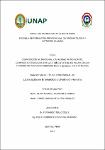Composición nutricional, capacidad antioxidante, compuesto fenólicos totales y b-caroteno en pulpa cruda y cocido de dos variedades de Bactris gasipaes H.B.K. (pijuayo)

View/
Date
2019Author
Donayre Linares, Gloria Isabel
Montalván Vásquez, Jorge Luis
Metadata
Show full item recordAbstract
El presente trabajo de investigación tuvo como propósito determinar la composición nutricional, capacidad antioxidante, contenido de compuestos fenólicos totales, β- carotenos y realizar una comparación entre dos variedades de pulpas analizadas (cruda y cocida) de Bactris gasipaes H.B.K (pijuayo).
Se evaluó el contenido de humedad, cenizas, carbohidratos; las proteínas, grasas y minerales fueron enviados y evaluados en la Certificadora y Laboratorio Alas Peruanas – CERTILAB SAC. La capacidad antioxidante fue evaluada mediante los métodos ABTS y DPPH. Compuestos fenólicos totales y β – caroteno.
Los resultados de la caracterización de la composición nutricional, para ambas variedades, en el porcentaje de humedad fueron superior al 50%, destacando además el contenido de carbohidratos y energía. En cuanto al contenido de minerales, el pijuayo de variedad amarilla presentó 16% más contenido de calcio en la etapa cruda que el pijuayo rojo, en la etapa cocida, las concentraciones en ambos frutos disminuyeron significativamente, por otro lado, el comportamiento del fosforo mostró aumento significativo (P<0,05) después de la cocción. Debido a su coloración, el pijuayo rojo presentó alta concentración de β-caroteno en ambas etapas (crudo y cocido), incluso después de la cocción hubo aumento en la concentración de β-caroteno, por lo tanto, la capacidad antioxidante del pijuayo de coloración rojo fue mayor en ambos métodos (ABTS y DPPH). The purpose of this research work was to determine the nutritional composition, antioxidant capacity, content of total phenolic compounds, β-carotenes and make a comparison between two varieties of pulps analyzed (raw and cooked) of Bactris gasipaes H.B.K (pijuayo).
The moisture content, ashes according to the AOAC method (2012), carbohydrates according to Minsa (2009); The proteins, fats and minerals were sent and evaluated in the Alas Peruanas Certifier and Laboratory - CERTILAB SAC. The antioxidant capacity was evaluated by ABTS and DPPH methods. Total phenolic compounds according to Sigleton et al 1999 and β-carotene according to Sotero & García (2009).
The results of the characterization of the nutritional composition, for both varieties, the percentage of humidity was higher than 50%, likewise, they stood out for their high carbohydrate and energy content. Regarding the mineral content, the yellow variety pijuayo presented 16% more calcium content in the raw stage than the red pijuayo, in the cooked stage, the concentrations in both fruits decreased significantly, on the other hand, the phosphorus behavior showed significant increase (P <0.05) after cooking. Due to its coloration, the red pijuayo presented high concentration of β-carotene in both stages (raw and cooked), even after cooking there was an increase in the concentration of β-carotene, therefore the antioxidant capacity of the red colored pijuayo It was higher in both methods (ABTS and DPPH).
Collections
- Tesis [170]
The following license files are associated with this item:

